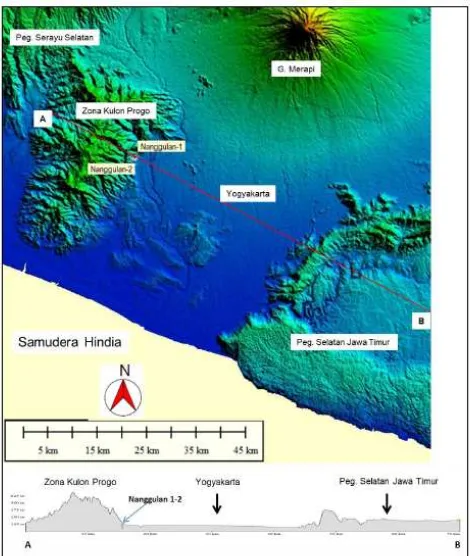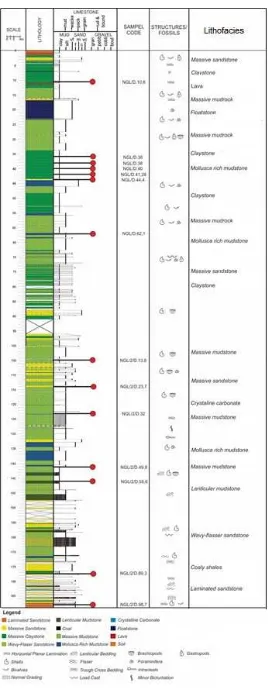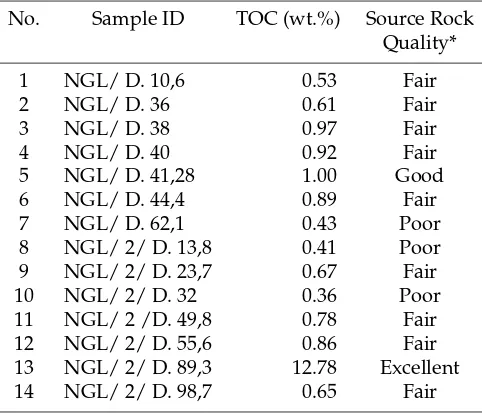Lithofacies and Sedimentation of Organic Matter in Fine Grained Rocks of
Nanggulan Formation in Kulon Progo, Yogyakarta
Hendra Amijaya∗, Najibatul Adibah, and Ahmad Z.A. Ansory
Department of Geological Engineering, Faculty of Engineering, Gadjah Mada University, Yogyakarta, Indonesia
ABSTRACT. Fine grained rocks especially shale play a significant role in shale hydrocarbon system. Research on Eocene Nanggulan shale becomes an interest lately since this shale is considered as prospective interval for shale gas source. It potentially contains signifi-cant organic matter because coaly sediment is found in this formation as well. Nanggulan Formation fine grained rocks was deposited in various depositional environment from estuary – shallow marine. This paper integrates the result of lithofacies and depositional environment analysis with organic geochemical data to understand the sedimentation pro-cess of organic matter. Samples were taken from cores. The result of 14 geochemically analysed samples shows Total Organic Carbon (TOC) content between 0.36–1.00 % for fin e grained rocks (shales) and 12.80 % for coaly shales. Nine samples are categorized as fair and 2 samples are categorized as good source rock. The depositional environment of Nanggulan Formation sediment, which was shallow marine at Late Eocene and estuary (salt marsh) at Early Eocene, produced sediment with higher TOC. Whereas the deposi-tion of sediment in estuary (tidal flat) at Middle Eocene produced lower content of TOC. Vulcanic activity at Middle Eocene also caused less organic material preservation because it produced abundant inorganic material.
Keywords: Fine-grained rock·Lithofacies·Organic matter·Nanggulan Formation· Ku-lon Progo.
1 INTRODUCTION
Indonesia is a country which is indicated hav-ing significant shale gas potential. This is sup-ported by data from Oil and Gas Directorate General, Ministry of Energy and Mineral Re-sources that stated the total speculative shale gas resource in Indonesia reached the number of 574 TCF (Wagimin, 2014). Study on fine grained rocks especially in petroleum system point of view becomes very important. Fine grained rocks especially shale play a significant role in shale hydrocarbon system.
Shale of Nanggulan Formation is one of Eocene rocks is widely exposed in south part of Central Java. Eocene Nanggulan shale becomes an interest lately since this shale is considered
∗Corresponding author: H. AMIJAYA, Department
of Geological Engineering, Gadjah Mada University. Jl. Grafika 2 Yogyakarta, Indonesia 55281. E-mail: hamijaya@ugm.ac.id
as prospective interval for shale gas source. It potentially contains significant organic matter because coaly sediment is found in this for-mation as well. However, inforfor-mation on the geochemical characteristic of this formation is relatively limited.
2 METHODOLOGY
The analysis was executed by composing 2 core data taken from Pandawarejo, Girimulyo and Banjararum, Nanggulan in Kulon Progo (named Nanggulan 1 and 2, see Figure 1). Lithofacies analysis was conducted by describ-ing facies parameters such as geometry, lithol-ogy, sedimentary structure, and fossil content. Determination of lithofacies association was based on the sedimentary rock succession in transitional to shallow marine environment by Nichols (2009).
TOC analysis was done using a LECO sul-fur analyzer at PT. Geoservices Ltd. Geological & Laboratory Services Division. This analysis was using 1 gram rock powder each of 14 fine-grained rock samples especially shales which had previously been cleared from calcareous components using HCl solution. The TOC value was then matched with lithofacies char-acteristics and depositional environment inter-pretation.
3 RESULTS ANDDISCUSSION
Lithofacies
From detailed core analysis as shown in Figure 2, 11 different facieses were defined, which are:
a. Laminated Sandstone Facies; Brownish
grey fine sand facies with subangular-subrounded grains, well-sorted, grain-supported, low to medium hardness, lam-inated structure, and consists of quartz, plagioclase, mollusk fragments, and fine sedimentary material.
b. Massive Sandstone Facies; Light grey fine-coarse sand facies with subangular grains, poorly to well-sorted, brittle, massive sed-imentary structure, and contains quartz, feldspars, and occasional mollusk and macro-foraminifer fragments.
c. Wavy-Flaser Sandstone Facies; Light grey fine-coarse sand facies with subangular grains, poorly to medium-sorted, low hardness, medium cementation, wavy-flaser and parallel bedding sedimen-tary structure, and composed of quartz, feldspars, mica, clay minerals, and mol-lusk and macro-foraminifer fragments. d. Massive Claystone Facies; Grey clay
fa-cies with massive sedimentary structure
and composed of clay minerals, quartz, feldspars, and occasional carbon flack and mollusk fragments. Generally, massive claystone facies is a non-calcareous facies. e. Massive Mudstone Facies; Calcareous grey
facies with clay-sized matrix and sand to gravel fragments, brittle, poorly-sorted, and lenticuler sedimentary structure. The matrix consists of clay minerals, while fragments are some mollusks and num-mulites.
f. Mollusk-rich Mudstone Facies; Calcareous grey facies with silt-sized matrix and sand to gravel (1-40 mm) fragments, poorly-sorted, and matrix-supported. The matrix consists of silt-sized sedimentary materials and calcareous minerals, while fragments are some mollusks, nummulites, discocy-clina, quartz, and feldspar.
g. Floatstone Facies; Calcareous dark grey facies with silt-sized matrix and more than 10% sand-gravel fragments, mud-supported, and contains calcareous mate-rials and macro-foraminifers.
h. Crystalline Carbonate Facies; Calcareous grey mud facies, crystalline, and consists of calcareous minerals, mollusca fragments, and calcite vein.
i. Coal Facies; Black lithology facies with dull luster, high hardness, and massive sedi-mentary structure. The coal contains face and butt cleat.
j. Interbedded Claystone and Sandstone Facies; Dark grey facies. Sandstone consists of very fine-coarse sand materials with occa-sional clay matrix, poorly-well sorted, and contains lithic, clay minerals, and mollusk fragments. Claystone consists of clay-sized materials and massive structure.
k. Lenticular Mudstone Facies; Calcareous dark grey facies with clay to silt-sized matrix and fine-coarse sand fragments, poorly-sorted, lenticuler and flaser sedimen-tary structure, and composed of quartz, feldspars, and mollusk fragments.
a. Upper Flow Regime (UFR) Sand Flats Facies Association
This facies association is made of lam-inated sandstone, massive sandstone, wavy-flaser sandstone, lanticular mud-stone, and massive claystone facies. Lami-nated sandstone facies consists of fine sand materials, which indicates an environment with fair to high depositional energy and specific current velocity (Boggs, 2006). Based on Hjulstrom diagram (in Nichols, 2009), fine-sand materials can be trans-ported with bed-load mechanism.
The sedimentary structure in wavy-flaser sandstone facies refers to depositional pro-cesses affected by a constantly changing hydraulic, while the structure in lenticular mudstone facies indicates sedimentation in a tide-influenced environment.
UFR sand flats facies association is a part of braided channels in a wide estuary. Those channels are tributing seaward. This facies is located in the meeting point of fluvial and tidal energy in a tide-dominated es-tuary. Sediments from this facies is made of fine sandstone with parallel lamination structure (Dalrymple and Davis, 2012). UFR sand flats also covers a part of the inner-most tidal channel that commonly are meandering channels (Nichols, 2009). In this facies, there are two kinds of cur-rent affecting the sedimentation; they are fluvial and tidal-current. Fluvial current produced sand-sized sediment deposits, while tidal current resulted in clay-sized deposits. These mechanisms enabled in-terbedded sandstone and claystone to be formed.
b. Salt Marsh Facies Association
From core analysis, salt marsh facies is represented by coal and massive claystone facies. Some bedding fissility is shown in the claystone and it also consists of non-calcareous composition. The coal is black, hard, and has cleats.
Salt marsh is a part of estuary beside tidal channels and tidal bar which situated closer to the land / continent. This fa-cies is dominated by fine-sized sediment with a little sand components and organic materials. Silt-sized sediment is mostly
composed of suspended organic materials; some of them are from the in-situ plants in the marsh itself. Deposition in salt marsh is controlled by organic activity rather than sedimentology processes (Dalrymple and Davis, 2012).
c. Tidal Flats Facies Association
Tidal flats facies association is dominated by massive sandstone and wavy-flaser sandstone facies in the lower part, and develops to massive mudstone, interbed-ded claystone and sandstone, and massive claystone facies.
d. Offshore Transition Facies Association
Offshore transition facies association is mostly dominated by massive mudstone facies with some mollusk-rich mudstone, massive claystone, crystaline carbonate, and massive sandstone facies.
From core analysis, it is known that the mollusk-rich mudstone and massive mud-stone facies have extremely-abundant mol-lusk fragments and macro-foraminifers, pointing to a shallow marine environment with high depositional energy. Crystalline carbonate facies indicates a dominant ma-rine influence in this environment.
e. Offshore Facies Association
Offshore facies association is the outer-most part of shallow marine environment (Nichols, 2009). The association is domi-nated by massive mudstone dan floatstone facies with some massive claystone dan massive sandstone facies interbeds.
Massive mudstone facies domination with a little massive sandstone interbeds leads us to a depositional environment with low energy situated in the marine. Floatstone facies with bunches of mollusk fragments and macro-foraminifers indicates that the facies association was formed near to car-bonate platform.
Organic matter content and its sedimentation
>1 wt.% considered as good potential to pro-duce hydrocarbons (see Table 1).
Table 1: Total Organic Carbon (TOC) content of fine grained sediments studied.
No. Sample ID TOC (wt.%) Source Rock Quality*
13 NGL/ 2/ D. 89,3 12.78 Excellent
14 NGL/ 2/ D. 98,7 0.65 Fair
*According to Peters & Cassa (1994)
Sample NGL/D.38; NGL/D.40; NGL/ D.41,28; NGL/D.44,4 have a good TOC rang-ing 0.89–1.00 wt.% which indicates a good organic matter preservation. Based on the char-acteristics of lithology, this shale facies has an association with shallow marine depositional environment in offshore section. This deposi-tional environment is sufficient to support the preservation of organic material, resulting a good TOC shale deposit.
In the other hand, TOC value from samples NGL/2/D.13,8; NGL/2/D.23,7; NGL/2/ D.32 is only about 0.36–0.67 wt.% which indicates poor organic matter preservation environment. Based on depositional environment interpreta-tion, this samples was taken from estuary de-posit. This environment was not suitable for organic matter preservation due to the influ-ence of tidal current. The increasing volcanic activity, known from the presence of volcanic material components in the rocks samples such as pyrite, quartz, feldspar and abundant tuff, was also disturbing the accumulation of organic rich material and decreasing percentage of TOC content in the rock.
Samples NGL/2/D.49,8; NGL/2/D.55,6 and NGL/2/D.89,3 have TOC value of 0.78 wt.%, 0.86 wt.% and 12.78 wt.%, respectively. Sample NGL/2/D.89,3 is coaly shales which was
de-posited at estuary mangrove swamp, while NGL/2/D.98,7, which has approximately 0.65 wt.% TOC content, was deposited in tidal-dominated estuary channel. The later deposi-tional environment is unfavorable for organic matter preservation and has a low percentage of TOC due to the high water circulation rate which hindering the organic-rich materials to accumulate. Besides that, the abundant sup-ply of inorganic material was also lowering the preservation of organic matter. Geological conditions such as depositional environment as mention above affecting the degree of organic matter preservation. Low energy environment, anoxic, and less supply of inorganic material will be condusive environment for organic-rich materials, which has potential to produce hydrocarbons, to be deposited.
In general, organic-rich shale which was formed during Late Eocene was deposited in shallow marine to open marine environment. This is an area that is free from volcanic de-bris supply and supports the development of anoxic environment that is good for TOC-rich rocks to accumulate. The depositional envi-ronment during Early Eocene – Middle Eocene was stream-affected estuary. This environment is actually good for the organic matter preser-vation, but the discovery of volcanic material supply showed that volcanic activity was quite affecting for the development of a good source rock. Mangrove swamp (estuary) depositional environment in this era was still favourable for the formation of organic material rich shale with thin coal inserts. But, this depositional environment was quite limited (see Heidrick and Marliyani, 2006), so that shale layer could not widely spread.
4 CONCLUSIONS
a. The Nanggulan Formation, Kulon Progo can be divided into 11 lithofacies with five facies association. Succession of lithofa-cies consist of Laminated sandstone facies,
Flow Regime (UFR) Sand Flats, Salt Marsh,
Tidal Flats,Offshore Transition, andOffshore. Depositional environment of Nanggulan Formation starts from fluvial, tidal domi-nant estuarine to shallow marine. In gen-eral, depositional environment is deepen-ing. Deposition process in the fluvial and estuarine influenced by river flow and tidal currents.
b. Fine grained sediment of Nanggulan Formation has sufficient quantity of or-ganic material to produce hydrocarbons with TOC values in coaly shales and shales ranging from 0.36–1.00 wt.% and 12.78 wt.%, respectively. Depositional environment is playing a big role in de-positing the organic-rich materials, due to the fact that Nanggulan Formation, which was deposited in several environment such as shallow marine (offshore) during Late Eocene, estuaries (mangrove swamp) dur-ing Early Eocene, and tidal flat estuaries during Middle Eocene, has various value of TOC. The first two environments have greater value compared to the later one. Intensive volcanic activity played role in declining the TOC value during Middle Eocene, due to abundant supply of inor-ganic materials.
ACKNOWLEDGEMENTS
Authors thank PT. Bukit Energy for their coop-eration in drilling and sampling activity.
REFERENCES
Boggs, S. J. (2006) Principles of Sedimentology and Stratigrafi, 4th Ed., Merill Publishing Company, Colombus, 662p.
Dalrymple, R.W., and Davis, R.A. (2012) Princi-ples of Tidal Sedimentology, Springer Science and Business Media B.V., 621p.
Heidrick, T.L. and Marliyani, G.I. (2006) Nanggulan tectonostratigraphy. Geological Engineering FT-UGM, 8p, (unpublished).
Nichols, G. (2009) Sedimentology and Stratigraphy, Wiley - Blackwell, United Kingdom. 419p.
Peters, K.E. and Cassa, M.R. (1994) Apllied Source Rock Geochemistry. In L. B. Magoon dan W.G. Dow, eds, The Petroleum System-From Source to Trap, AAPG Memoir 60, Tulsa: American Assosi-ation of Petroleum Geologist, p. 93-120.
Rahardjo, W., Sukandarrumidi, and Rosidi, H.M.D. (1995) Peta Geologi Lembar Yogyakarta, Jawa, Pusat Penelitian dan Pengembangan Geologi, Bandung.
Wagimin, N. (2014) Unconventional Oil & Gas De-velopment in Indonesia, Workshop Migas Non Konvensional, Directorate General Oil and Gas, Ministry of Energy and Mineral Resources, Pre-sentation.


